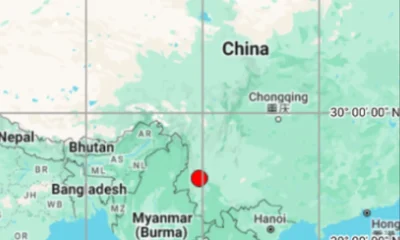Politics
Pokhran Anniversary: Unraveling the Significance of May 11, 1998 in India’s History
Pokhran Anniversary: Unraveling the Significance of May 11, 1998 in India’s History
The Shakti series of nuclear tests, carried out by India under NDA Prime Minister Atal Bihari Vajpayee on May 5 and May 11 at Pokhran, marked a turning point in the country’s nuclear capabilities about both clean energy and national security 26 years ago. India has advanced significantly in the interim with a complete, operational, and highly capable nuclear triad and a strong second-strike capability thanks to nuclear-powered ballistic missile-firing submarines. India declared itself to be a nuclear weapon state by detonating a variety of devices, from thermonuclear to tactical. India now possesses 5000 km of land-based Agni ballistic missiles and 3000 km of submarine-based K-4 ballistic missiles, which are capable of protecting India from threats from China, Pakistan, and other countries.
The most significant aspect of Vajpayee’s decision to test was that India for the first time acknowledged China as the primary reason for Bharat becoming nuclear, even if nuclear deterrence has helped India resist the military and diplomatic pressure of powerful nations. “We have an overt nuclear weapon state on our borders, a state that committed armed aggression against India in 1962.” Vajpayee wrote in a letter to then-US President Bill Clinton on May 13, 1998, “to add to the distrust that country has materially helped another neighbor of ours to become a covert nuclear-weapon state.” That day exposed China’s threat to India, as up until then, neither the Indian government nor the media had mentioned China by name. The Buddha grinned that day, and the Communist state was Voldemort in India.
The threat posed by China and the Communist dictatorship has not diminished even after twenty years; in fact, it has grown because of worries that the pro-Beijing Muizzu administration in the Maldives may soon lease an island to the PLA so that it may create a base. The Maldives has received clear communication from India that this is unacceptable and would have dire consequences. China has expanded the number of intermediate-range ballistic missiles in its arsenal, while Pakistan is working to develop MIRV technology in response to India’s asymmetric conventional threat. Another issue is that China is utilizing Pakistan as a springboard for jihad against the Indian hinterland.
Following the Shakti series of tests, the then-opposition, especially the Left parties and Leftist media, attacked Prime Minister Vajpayee, and the government had to resist US pressure to sign the CTBT through pro-West Indian media. Nonetheless, under Vajpayee, India was able to withstand pressure and sanctions, even though the world declared India to be a nuclear pariah, with the exception of France in the P-5. Four years later, on July 28, 2002, Secretary of State Colin Powell made the offer to National Security Advisor Brajesh Mishra for the civilian nuclear deal.
Also Read: Revanth Reddy’s ‘One Year Left’ Reminder to PM Modi Echoes ‘Retirement at 75’ Policy Critique
Prime Minister Narendra Modi destroyed the nuclear flashpoint theory, which was used by India’s enemies in the west to put pressure on India over Kashmir on behalf of Pakistan, by carrying out surgical strikes and Operation Bandar in Balakot, Pakistan, in response to terror attacks for which Rawalpindi GHQ refused to respond. To guarantee that Bharat is included in the response to climate change, the same Indian capability is being used today to develop sustainable energy. It was May 11, 1998, that marked India’s global debut.












